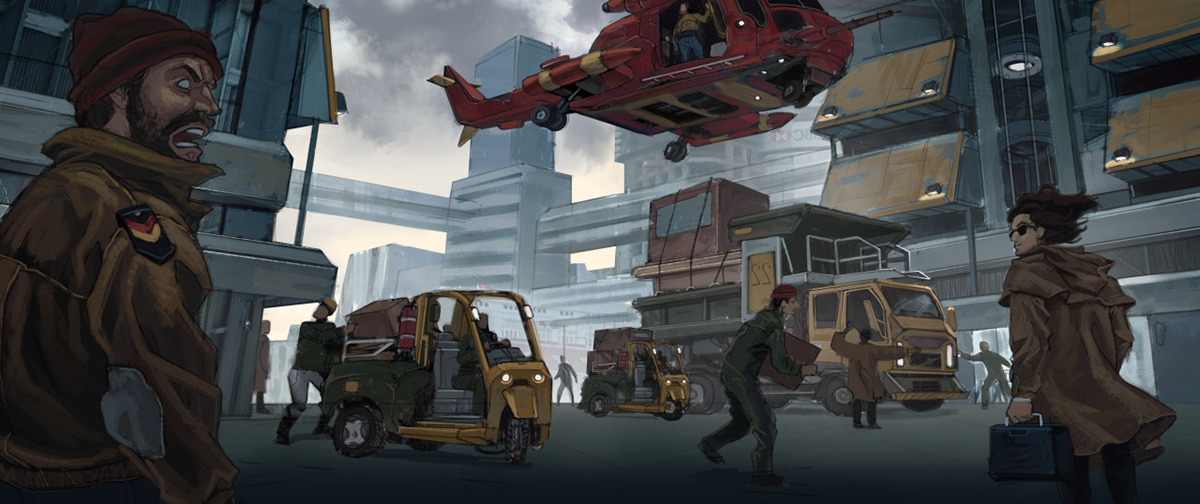









Helicopter Landing Process
01. This is the initial sketch. The main thing I focused on was the overall composition and value distribution. I knew that I wanted the helicopter coming down from the top, with a few people in the foreground leading the viewer’s eye to the helicopter.
02. On multiple layers, I drew over the initial sketch. With the use of reference photos, I created a solid line drawing which would later become the foundation of the painting. I later merged all the layers containing the line drawing.
03. Due to the relatively high level of detail and complexity in the line drawing, I was afraid the drawing would end up looking flat like a wallpaper. I knew that I would have a challenge creating a believable sense of depth and atmospheric perspective. To make my job easier, I created a series of gray shapes on diverse layers, with the darkest shapes in the foreground and the lightest shapes in the background. This would make it easier for me to paint some atmosphere in-between shapes to seemingly create more distance between them.
04. At this stage, I attached a plethora of textured photos onto the shapes in order to give me a starting point in my rendering process. Rather than beginning my painting process on a smooth canvas, I sometimes like to start with a few textured photos in order to help speed up my painting process. Some of these textures are still faintly visible in the final painting.
05. Before getting into “paint mode”, I darkened and lightened some of the layers to push and pull some of the shapes closer and further. The layer containing the background skyscrapers were lightened to push them back further from the viewer while the layer with the truck and 3-wheeled carts was darkened to bring them closer to the viewer.
06. this is where the painting process really began. At this point, I was focusing on the local color while still being watchful of my value choices.
07. The painting was finally beginning to get fleshed out at this stage. I was still being watchful of my value choices. The painting was beginning to look a little flat at this point.
08. I intensified the atmospheric perspective by pushing some of the shapes back even further. This was achieved by literally painting fog with the basic Photoshop airbrush. As a matter of fact, painting fog is a good way to save a painting from falling flat.
09. Prior to this stage, I had been painting underneath the line drawing; but at this point, I was finally able to move this painting toward completion by painting on a layer above the line drawing. Once again, the painting was falling flat, and I was losing the depth that I had previously created. I had to be careful not to completely lose it. I added a pointing hand onto the figure on the extreme left in order to direct the viewer’s eye to the helicopter. My goal was to have the viewer’s eye go from the figure in the left to the helicopter, then to the landing spot, then to the man carrying the box, then to the man with the sunshades carrying the briefcase, and finally back to the figure on the left.
10. To finalize the painting, I painted in even more fog, and I also went as far as painting debris to imply the beginning of a snowstorm. I also darkened the foreground figures to bring them closer to the viewer. I added a few more details here and there, and I also blurred part of the helicopter to create an illusion of motion.


